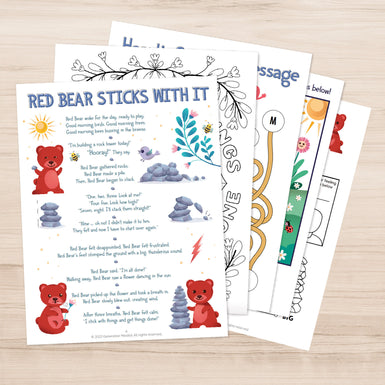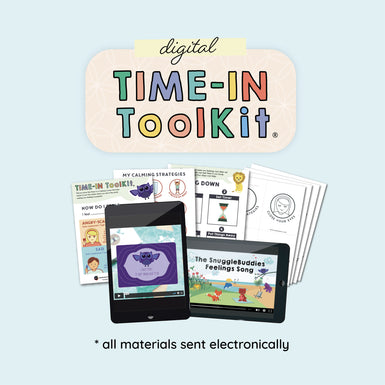I remember being a little girl and feeling responsible for other people’s feelings. If I just did this or did less of that then they would be happy, and I would have a safe place inside of my family system. I quickly learned which parts of myself to shrink and which parts to grow to appease my attachments so that my needs (survival) could be met. It’s pretty wild how we are designed to protect ourselves, even at the youngest of ages. Fast forward 30 years, and I still find myself apologizing for things that don’t warrant an apology, feeling uncomfortable setting a boundary, and taking on others’ emotions as my own.
The Messages We Send About Feelings
“You hurt my feelings!”
“You make me so mad!”
What do these messages have in common?
Well, to start with, they are likely things we have heard many times before. And, because most of us are wired to say them given our upbringing, they are likely words we have spoken to our children, too.
I have read that there are two types of guilt. The first type is felt when we don't act per our values. The second type involves someone else’s internal experience, for example, if we set a boundary, act, or answer in a way that displeases another person, their discomfort and disappointment can be transmuted into our guilt. In this article, we are talking about the latter.
So, why do we do this?! Many times, it is caused by adaptations and limiting beliefs we acquired in childhood.
Close your eyes and invite yourself back to being your child self. Recall a time you remember being punished for having wants, needs, big emotions, and/or for making a mistake. Perhaps it was a time when you were ...
- spanked or isolated for feeling upset or having a meltdown
- told “You’re fine”, “Stop crying”, or “Don’t be sad”
- shamed for acting in a way that was inconvenient for the adults in your life
- manipulated by adults, who said: “You hurt my feelings” or “You make me so mad”
In these moments, you may have internalized one or more of the following limiting beliefs:
- my wants and desires are bad.
- It is unsafe to feel or express emotions. My feelings are wrong.
- I better act how others want so that I fit in.
- my caregivers’ feelings are my responsibility and I better show up in ways that leave them feeling good or happy.
When, as children, we are asked to lessen our boundaries to balance our family system to ensure that we keep our attachments close (because we need them for survival), we grow up living these same patterns. Our boundaries can become unclear to us, and we can struggle to set and respect them. The space between our feelings and someone else’s becomes narrow, so much so that the line blurs and there is no real distinction between where one begins and one ends.
We are children who grow into adults questioning why these things feel hard, wondering what’s wrong ...
- Why can’t I just say no …
- Why do I care so much about what others think …
- Why do I feel the need to be perfect?
And while our minds may give us logical answers, our body stores the information from our past and uses what it knows to keep us safe.
But here’s the cool thing. While our brain is already 75% wired by age three and 90% by age five, our brain is plastic, which means it is changeable and capable of creating new circuits.
The Truth About Feelings
When we say things such as, “You hurt my feelings,” we can pitfall into a victim mindset … that someone did something to us and made us feel, think or act in a certain way. And while these phrases are meant to be a harmless way for parents to share their feelings, they may not effectively communicate our message.
In recognizing the following three truths about feelings, we reclaim our power.
1. You can’t hurt my feelings and I can’t hurt yours.
I am in charge of my feelings because they belong to me. They are intimate vibrations that live inside. What I feel and think has to do with my history as it buds up to the current moment. What you feel and think has to do with how your story influences the present moment. When we feel provoked by something, it isn’t necessarily about what is happening externally, but the meaning our internal selves ascribe to it, so, in that way, we don’t cause other people’s feelings, we trigger them. Triggers are an invitation to learn more about ourselves and grow.
2. Everyone is allowed to have their feelings.
When you were a child, if the adults in your life escalated during your dysregulation, or their feelings overrode your needs, you may have developed the ideology that feelings are bad, especially unpleasant ones. But, we all have a wide spectrum of emotions and our emotions are both useful and informative. We don’t have to attempt to control other’s feelings because they aren’t ours to control. We are allowed to set the boundary that feels good to us and others are allowed to feel however they'd like to feel about it.
3. Empathy and co-dependency are separate things.
For generations, we have struggled to differentiate our feelings from other people's feelings, but there is a big difference between empathy and co-dependence.
Empathizing with another person is putting yourself in their shoes with healthy boundaries in place. It says: "You are over there with your feelings, and I care about them. I am here for you, and your feelings don’t enmesh with mine."
Co-dependency says: "You are over there with your feelings, and I am feeling your feelings so deeply that they have passed through my boundaries. Your feelings are now my feelings, and because of this, I will modify my behavior, wants, needs, and desires to protect you from these feelings."
Bottom line: We can’t be empathetic and co-dependent simultaneously.
Tools For Navigating Feelings
So, how do we re-write the narratives? Here are three helpful strategies:
1. Re-visit your inner child
The child inside of you who felt responsible for his or her attachment’s feelings is waiting for you to let her off the hook. Let her know that she doesn’t have to feel scared anymore, nor does she need to shrink or grow to “make" someone else happy. Tell her that she is good even when she makes a mistake. Follow your current day triggers and tell yourself whatever it is that you might have benefited from hearing back then. When we do this, we surround our feelings of guilt and self-blame with compassion, and it helps us re-wire our brain towards seeking authentic connection, instead of inauthentic and unattainable goals for people-pleasing and/or "perfection".
2. Own your emotions
Humans are not meant to be void of emotions. Emotions are energy in motion and they are meant to move through us. As we parent our children, we can give ourselves permission to feel our many emotions, rather than dismiss and deny them.
Our children don’t feel unsafe or insecure because we have, share, or process our emotions, but, rather, when we 1) pretend we don’t have them, 2) become overwhelmed by our emotions and explode, and 3) when we make it our children’s job to regulate us.
Demonstrate noticing and naming your feelings using “I statements”. For example:
- Instead of “You make me so mad”, you might say, “I feel frustrated when the toys aren’t picked up. How can we work on this together?”
- Instead of “You hurt my feelings,” you might say, “I feel sad when I am hit. It’s okay to have big feelings. It’s not okay to hurt other people by hitting them.”
Our role isn’t to be happy or calm 100% of the time. When we allow ourselves to feel all emotions and model how to acknowledge and own our distress, we make it safe for our kids to do the same.
3. Create new mantras
Like many things in parenting, two things that seem opposite on the surface can be true at the same time. It is helpful to restate these opposites, connecting them with the word "and". For example:
- I am allowed to feel my emotions and I can change my feelings with my thoughts.
- The child within me created protective mechanisms and I no longer have to be responsible for others’ thoughts and feelings.
- I am allowed to have boundaries, wants/needs, and other people are allowed to feel however they like about my boundaries, wants/needs.
- My kids will have big emotions and I can help them co-regulate without blame, shame, or pain.
For ourselves and our children, we can step into our power, teaching our children where true power lives, which is in OUR thoughts, words, and actions. and not in other people’s.


























